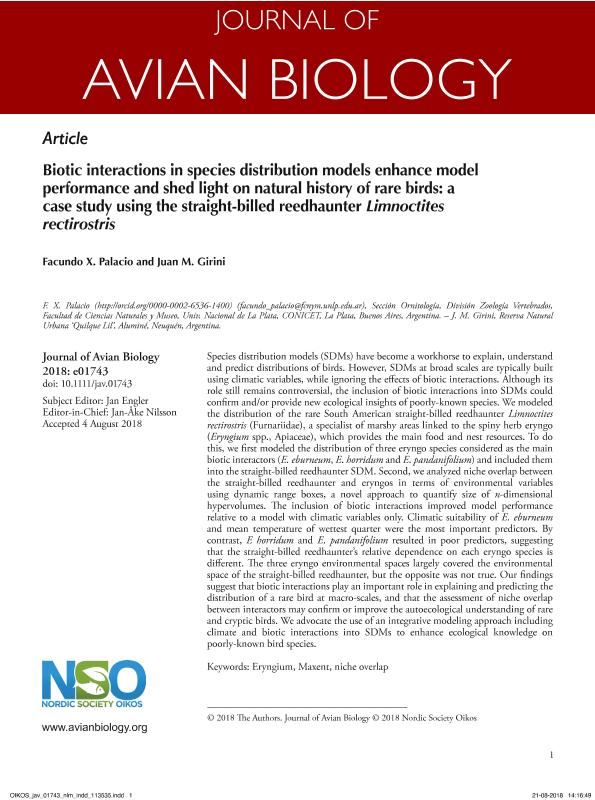Artículo
Biotic interactions in species distribution models enhance model performance and shed light on natural history of rare birds: a case study using the straight-billed reedhaunter Limnoctites rectirostris
Fecha de publicación:
11/2018
Editorial:
Wiley Blackwell Publishing, Inc
Revista:
Journal Of Avian Biology
ISSN:
0908-8857
Idioma:
Inglés
Tipo de recurso:
Artículo publicado
Clasificación temática:
Resumen
Species distribution models (SDMs) have become a workhorse to explain, understand and predict distributions of birds. However, SDMs at broad scales are typically built using climatic variables, while ignoring the effects of biotic interactions. Although its role still remains controversial, the inclusion of biotic interactions into SDMs could confirm and/or provide new ecological insights of poorly-known species. We modeled the distribution of the rare South American straight-billed reedhaunter Limnoctites rectirostris (Furnariidae), a specialist of marshy areas linked to the spiny herb eryngo (Eryngium spp., Apiaceae), which provides the main food and nest resources. To do this, we first modeled the distribution of three eryngo species considered as the main biotic interactors (E. eburneum, E. horridum and E. pandanifolium) and included them into the straight-billed reedhaunter SDM. Second, we analyzed niche overlap between the straight-billed reedhaunter and eryngos in terms of environmental variables using dynamic range boxes, a novel approach to quantify size of n-dimensional hypervolumes. The inclusion of biotic interactions improved model performance relative to a model with climatic variables only. Climatic suitability of E. eburneum and mean temperature of wettest quarter were the most important predictors. By contrast, E horridum and E. pandanifolium resulted in poor predictors, suggesting that the straight-billed reedhaunter's relative dependence on each eryngo species is different. The three eryngo environmental spaces largely covered the environmental space of the straight-billed reedhaunter, but the opposite was not true. Our findings suggest that biotic interactions play an important role in explaining and predicting the distribution of a rare bird at macro-scales, and that the assessment of niche overlap between interactors may confirm or improve the autoecological understanding of rare and cryptic birds. We advocate the use of an integrative modeling approach including climate and biotic interactions into SDMs to enhance ecological knowledge on poorly-known bird species.
Palabras clave:
ERYNGIUM
,
MAXENT
,
NICHE OVERLAP
Archivos asociados
Licencia
Identificadores
Colecciones
Articulos(CCT - LA PLATA)
Articulos de CTRO.CIENTIFICO TECNOL.CONICET - LA PLATA
Articulos de CTRO.CIENTIFICO TECNOL.CONICET - LA PLATA
Citación
Palacio, Facundo Xavier; Girini, Juan Manuel; Biotic interactions in species distribution models enhance model performance and shed light on natural history of rare birds: a case study using the straight-billed reedhaunter Limnoctites rectirostris; Wiley Blackwell Publishing, Inc; Journal Of Avian Biology; 49; 11; 11-2018; 1-12
Compartir
Altmétricas




